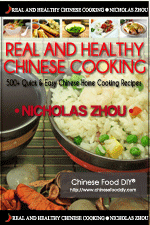



   
 


|

|
|
|
|
Home
>
Cooking Tips
> Twenty Tips for
Cooking Chinese Food
Twenty Tips for
Cooking Chinese
Food
|

|

|
 |
 |
 |
Twenty Tips for Cooking Chinese Food |
|
Try to
vary the meat and vegetables in a dish, so that
there is an interesting variety of flavors,
textures, and colors. Prepare everything before
you start cooking: meat, vegetables, and
sauces.
Wash green, leafy vegetables ahead of time. This
gives them more time to drain so they will not
be too wet when you stir-fry.
While it's nice to own one, you don't need a
cleaver to cook Chinese food.
Place all the cut vegetables on a tray or
cooking sheet. That way, you won't forget
anything. Just be careful not to mix them up, as
cooking times will vary among vegetables.
Drain tofu before using, as this allows it to
absorb the other flavors in the dish.
Marinate fresh meat.
Always cut beef across the grain.
Cut the meat into uniform pieces so that it will
cook more evenly. If you're not using a recipe,
a general rule is to cut everything into
bite-sized pieces.
When adding oil for stir-frying, drizzle the oil
down the sides of the wok.
When deep-frying, to tell if the oil is hot
enough, simply stick a chopstick in the wok.
When the oil sizzles all around it, you can
begin adding the food.
Don't use dark
soy sauce unless the recipe
specifically calls for it. When a recipe simply
says to add soy or soya sauce, use light
soy sauce or one of the Japanese brands such as
Kikkoman.
If preparing stir-fried meat and vegetables,
stir-fry the meat first and set it aside.
Usually you will return it to the wok with a
sauce during the final stages of cooking.
When stir-frying vegetables, cook the toughest
and thickest vegetables for a longer period than
the softer, leafy vegetables. Vegetables such as
broccoli, carrots, and cabbage need to be cooked
longer than bok choy, which in turn is cooked
longer than snow peas or bean sprouts.
If you are uncertain in what order to cook
vegetables, simply stir-fry them separately.
Never overcook.
Once you've gained a bit of experience and can "guestimate"
amounts such as one teaspoon or two
tablespoons, try storing sauces in plastic
containers similar to the syrup dispensers used
in restaurants. This cuts down on the amount of
washing up after each meal. Just be sure to
label each of the containers!
Always use fresh
ginger, not powdered.
If desired, use sugar as a substitute for
MSG
(Monosodium Glutamate).
The formula for mixing
cornstarch and water is 1
to 2: for example, 1 tablespoon of
cornstarch
with 2 tablespoons of water
Taste the dish and adjust the seasonings as
desired.
And finally, in the immortal words of one of my
favorite cooking teachers: "the two most
important things about Chinese cooking are a hot
stove and a sharp knife. |

[ Back
to Chinese Cooking Tips Index]
Get ready to
cook Chinese food?
Click here to see
500+ Real and Healthy Chinese Food Recipes
in 5 minutes! Plus 200+ cooking
tips and 170+ colorful pictures.
|
"500+ Healthy Chinese Recipes in 5 minutes"
|

|
ChineseFoodDIY's
cookbook "Real & Healthy Chinese Cooking" -
500+ low carb and low fat recipes with 170+ colorful pictures.
Based on a master chef's 40 years of cooking practice and 4 years of writing
and research, it has helped over 12,800 people worldwide improve
their health. All the secret copy cat recipes in ONE cookbook.
Click here to read the whole story that reveals how
ANYONE can cook delicious Chinese food and improve their health... in less than 20
minutes. | |
Related Links:
Chinese Food & Chinese
Cuisine

|
|
|
|
|
|
|
|

|
|

|
|
